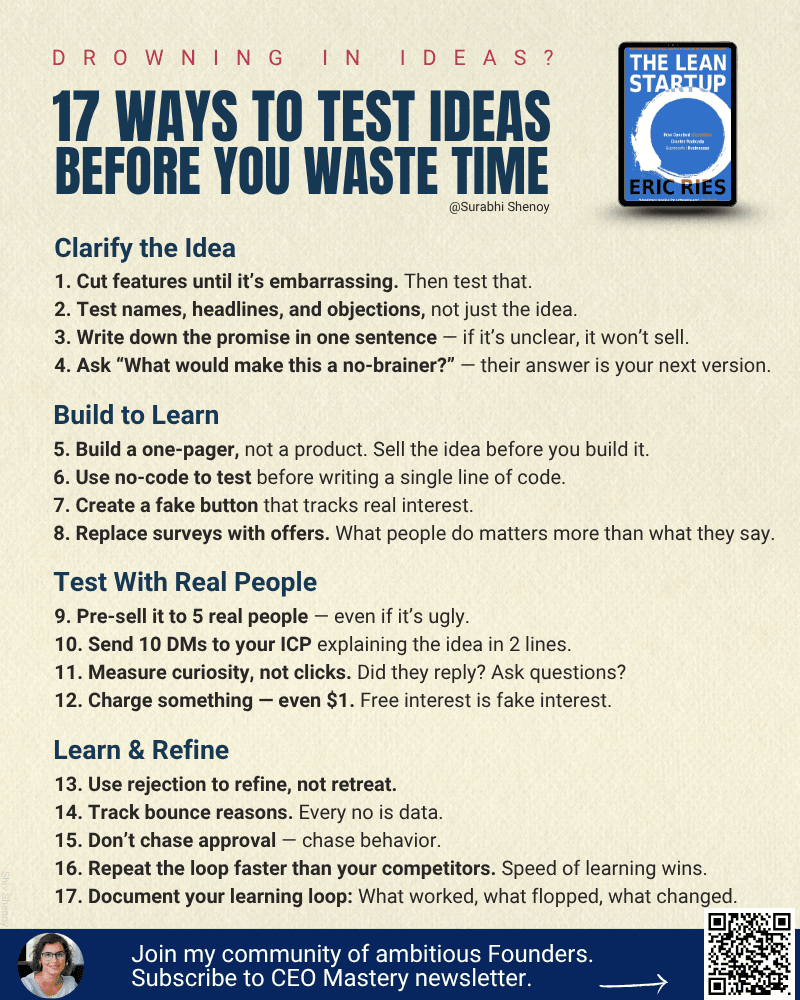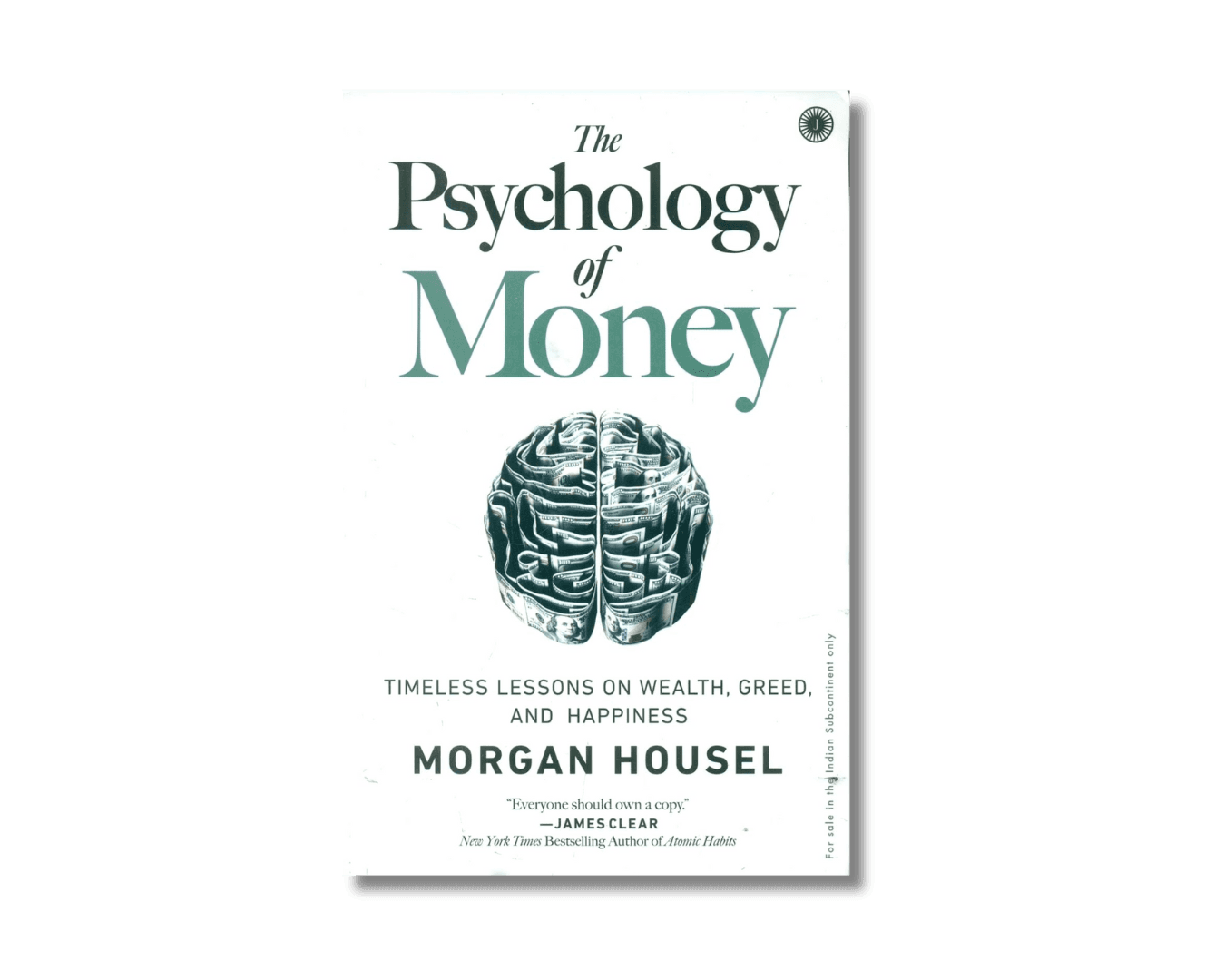Last week, I spent 3 hours with a founder who had 7 startup ideas in a Notion doc.
Zero customers.
Sound familiar?
Every week, I meet founders who aren’t stuck because of a lack of ideas— but because they have too many.
AI has made it worse:
- New tools
- New features
- New monetization paths
- New distractions
But more ideas don’t create clarity. They create paralysis.
That’s why I revisited The Lean Startup by Eric Ries after my own bout with idea overload last month.
And I remembered why it became a movement.
It didn’t just teach us how to build. It changed how we think.
From Big Plans to Small Experiments
Before The Lean Startup
Startups copied big companies:
- 40-page business plans
- 5-year forecasts
- Locked-in roadmaps
Founders thought: “If it fails, it means I failed.”
After The Lean Startup
Failure became data. Learning replaced guessing. Pivots became smart — not shameful.
It gave us permission to drop the facade. To say: “I don’t know yet. But I’m learning fast.”
The Lean Startup taught us that:
- Success ≠ building big.
- Success = building small, testing fast, and learning early.
It turned startup chaos into a repeatable process: Build → Measure → Learn
And that mindset? It’s exactly what today’s founders need.
The Build-Measure-Learn Cycle That Changes Everything
The core of lean startup methodology is simple:
Build the smallest thing that tests your biggest assumption.
Measure real customer behavior (not opinions).
Learn from the data and decide what’s next.
Most founders get stuck because they skip straight to building the full product. They spend months perfecting features nobody wants.
The lean approach flips this. You start with the riskiest assumption and test it in days, not months.
5 Lessons That Still Hold Up
- A product isn’t an MVP. A landing page with a clear promise is.
- “I would use this” is not validation. Money is.
- The faster you learn, the less you waste.
- A pivot isn’t failure — it’s a signal you’re paying attention.
- What people do > what people say. Always.
17 Ways to Validate Ideas Before You Waste Time
After re-reading The Lean Startup and applying it to dozens of founder conversations, I created this validation list. These methods help you test ideas quickly, cheaply, and with real feedback.
💡 Clarify the Idea
- Cut features until it’s embarrassing. Then test that.
- Test names, headlines, and objections—not just the product.
- Write down the promise in one sentence. If it’s unclear, it won’t sell.
- Ask: “What would make this a no-brainer?” — their answer is your next version.
🛠️ Build to Learn
- Build a one-pager, not a product. Sell before you build.
- Use no-code tools to test fast.
- Create a fake button to track real interest.
- Replace surveys with offers. What people do matters more than what they say.
📊 Test With Real People
- Pre-sell to 5 real people—even if it’s ugly.
- Send 10 DMs to your ideal customer explaining the idea in 2 lines.
- Measure curiosity, not clicks. Did they reply? Did they ask questions?
- Charge something—yes, even $1. Free interest is fake interest.
🔁 Learn & Refine
- Use rejection to refine, not retreat.
- Track bounce reasons. Every no is data.
- Don’t chase approval—chase behavior.
- Repeat the loop faster than your competitors.
- Document your learning: what worked, what flopped, what changed.

Common Objections (And Why They're Wrong)
"But my idea is too complex for an MVP"
This is the biggest myth in startups.
Even complex B2B software can be tested with simple methods:
- Create a manual process first
- Test one core workflow
- Use existing tools to fake the backend
- Focus on the outcome, not the features
Netflix started by mailing DVDs.
Uber began with SMS and phone calls.
Your “complex” idea probably has one simple core that you can test today.
"What if competitors copy my simple version?"
Good news: they won’t.
Most companies are too busy building their own features to copy your MVP. And if they do copy you? That means you found something worth copying.
Competition validates demand. It doesn’t kill it.
The real risk isn’t competitors copying your MVP. It’s building something nobody wants while worrying about competitors.
"How do I know when to pivot vs. persist?"
This is where most founders get stuck. Here’s the simple test:
Pivot when: You’ve run multiple valid tests and consistently get the same negative signal. People aren’t engaging, paying, or coming back.
Persist when: You’re seeing positive signals but need to improve execution. People want it but your current approach isn’t quite right.
The danger zone: Pivoting after one failed test or persisting despite months of clear negative feedback.
Set a learning budget upfront. “I’ll test this idea with 3 different approaches over 6 weeks.” Stick to your timeline.
How It Applies in the AI Era
Today, you can spin up a landing page in 10 minutes.
You can automate demos, outreach, and even mock prototypes.
But tools alone don’t create traction. If you’re not testing real user behavior, you’re just building in isolation—faster.
In fact, The Lean Startup feels more relevant now than when it was written. Because the barrier isn’t shipping anymore— the barrier is validating.
AI gives us superpowers for building. But it can’t tell us what to build. That still requires real humans and real feedback.
Who Should Read This Book
The Lean Startup is essential for:
- Founders paralyzed by too many ideas
- Product teams stuck in perfection cycles
- Innovators trying to de-risk new launches
- Startup coaches and advisors
- Solo creators launching something new
Whether you’re launching your first MVP or scaling your fifth product, this book is your blueprint for fast, evidence-based progress.
From Overthinking to Validation
This book isn’t about building faster. It’s about learning faster.
And when you adopt that mindset, the chaos starts to make sense.
You stop asking:
“Is this idea good enough?”
And start asking:
“How do I prove it — this week?”
That’s the shift. And that’s the freedom.
The next time you’re drowning in ideas, remember: you don’t need better ideas. You need better tests.
Read Next
Atomic Habits → How company identity is shaped by the habits you systematize
The E-Myth Revisited → Escape the founder’s trap and build a business that runs without you




